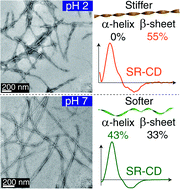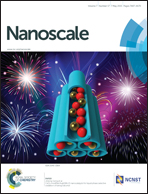Mechanical properties of amyloid-like fibrils defined by secondary structures†
Abstract
Amyloid and amyloid-like fibrils represent a generic class of highly ordered nanostructures that are implicated in some of the most fatal neurodegenerative diseases. On the other hand, amyloids, by possessing outstanding mechanical robustness, have also been successfully employed as functional biomaterials. For these reasons, physical and chemical factors driving fibril self-assembly and morphology are extensively studied – among these parameters, the secondary structures and the pH have been revealed to be crucial, since a variation in pH changes the fibril morphology and net chirality during protein aggregation. It is important to quantify the mechanical properties of these fibrils in order to help the design of effective strategies for treating diseases related to the presence of amyloid fibrils. In this work, we show that by changing pH the mechanical properties of amyloid-like fibrils vary as well. In particular, we reveal that these mechanical properties are strongly related to the content of secondary structures. We analysed and estimated the Young's modulus (E) by comparing the persistence length (Lp) – measured from the observation of TEM images by using statistical mechanics arguments – with the mechanical information provided by peak force quantitative nanomechanical property mapping (PF-QNM). The secondary structure content and the chirality are investigated by means of synchrotron radiation circular dichroism (SR-CD). Results arising from this study could be fruitfully used as a protocol to investigate other medical or engineering relevant peptide fibrils.


 Please wait while we load your content...
Please wait while we load your content...